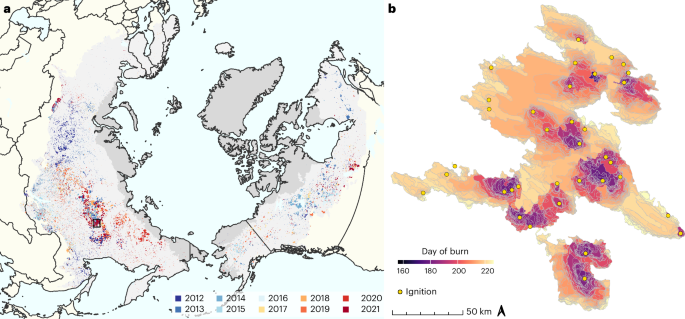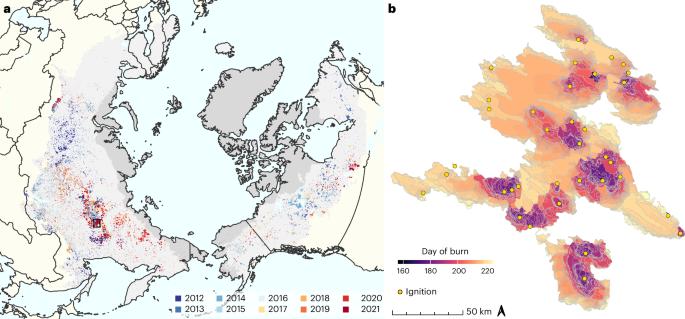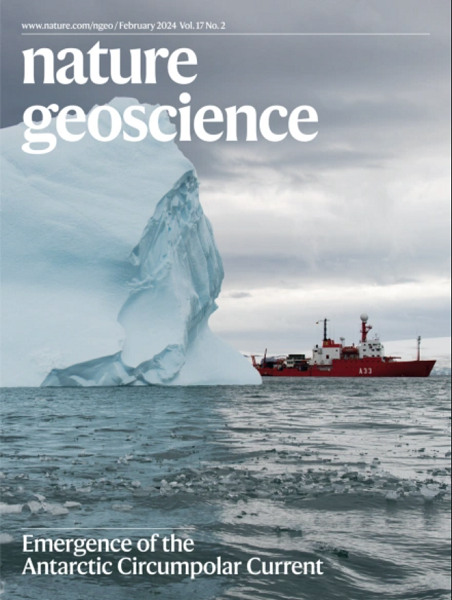Spatial variability in Arctic–boreal fire regimes influenced by environmental and human factors
IF 15.7
1区 地球科学
Q1 GEOSCIENCES, MULTIDISCIPLINARY
引用次数: 0
Abstract
Wildfire activity in Arctic and boreal regions is rapidly increasing, with severe consequences for climate and human health. Regional long-term variations in fire frequency and intensity characterize fire regimes. The spatial variability in Arctic–boreal fire regimes and their environmental and anthropogenic drivers, however, remain poorly understood. Here we present a fire tracking system to map the sub-daily evolution of all circumpolar Arctic–boreal fires between 2012 and 2023 using 375 m Visible Infrared Imaging Radiometer Suite active fire detections and the resulting dataset of the ignition time, location, size, duration, spread and intensity of individual fires. We use this dataset to classify the Arctic–boreal biomes into seven distinct ‘pyroregions’ with unique climatic and geographic environments. We find that these pyroregions exhibit varying responses to environmental drivers, with boreal North America, eastern Siberia and northern tundra regions showing the highest sensitivity to climate and lightning density. In addition, anthropogenic factors play an important role in influencing fire number and size, interacting with other factors. Understanding the spatial variability of fire regimes and its interconnected drivers in the Arctic–boreal domain is important for improving future predictions of fire activity and identifying areas at risk for extreme events. Arctic–boreal biomes vary regionally in the sensitivity of their fire regime to climate, according to an analysis of properties of individual fires measured by satellite radiometry.


受环境和人为因素影响的北极林火制度的空间变异性
北极和北方地区的野火活动正在迅速增加,对气候和人类健康造成了严重后果。火灾频率和强度的区域长期变化是火灾机制的特征。然而,人们对北极-北方火灾机制的空间变化及其环境和人为驱动因素仍然知之甚少。在此,我们介绍一种火灾跟踪系统,利用 375 米可见红外成像辐射计套件的主动火灾探测以及由此产生的单个火灾的点火时间、地点、规模、持续时间、蔓延和强度数据集,绘制 2012 年至 2023 年期间北极环极地区所有滨火的亚日常演变图。我们利用该数据集将北极滨海生物群落划分为七个不同的 "火区",这些 "火区 "具有独特的气候和地理环境。我们发现,这些火区对环境驱动因素的反应各不相同,其中北美洲北部、西伯利亚东部和北部苔原地区对气候和闪电密度的敏感度最高。此外,人为因素与其他因素相互作用,在影响火灾数量和规模方面发挥着重要作用。了解北极-寒带地区火灾机制的空间变异性及其相互关联的驱动因素,对于改进未来火灾活动预测和确定极端事件风险地区非常重要。
本文章由计算机程序翻译,如有差异,请以英文原文为准。
求助全文
约1分钟内获得全文
求助全文
来源期刊

Nature Geoscience
地学-地球科学综合
CiteScore
26.70
自引率
1.60%
发文量
187
审稿时长
3.3 months
期刊介绍:
Nature Geoscience is a monthly interdisciplinary journal that gathers top-tier research spanning Earth Sciences and related fields.
The journal covers all geoscience disciplines, including fieldwork, modeling, and theoretical studies.
Topics include atmospheric science, biogeochemistry, climate science, geobiology, geochemistry, geoinformatics, remote sensing, geology, geomagnetism, paleomagnetism, geomorphology, geophysics, glaciology, hydrology, limnology, mineralogy, oceanography, paleontology, paleoclimatology, paleoceanography, petrology, planetary science, seismology, space physics, tectonics, and volcanology.
Nature Geoscience upholds its commitment to publishing significant, high-quality Earth Sciences research through fair, rapid, and rigorous peer review, overseen by a team of full-time professional editors.
 求助内容:
求助内容: 应助结果提醒方式:
应助结果提醒方式:


